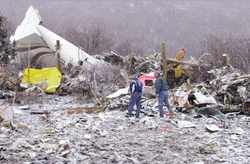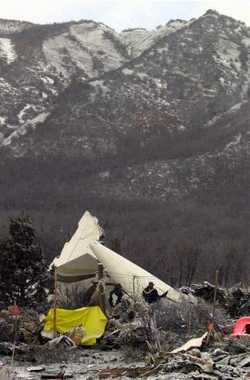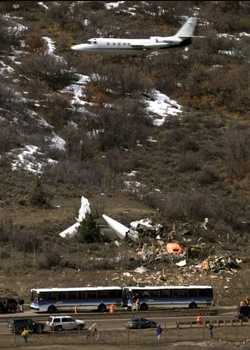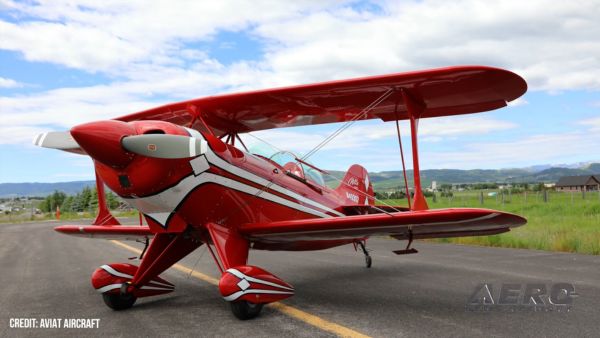 In the wake of its report on last
year's Avjet's crash in Aspen (CO), that took 18 lives ("Aspen Crash Report Disclosed"), the
NTSB has again recommended better cockpit management.
In the wake of its report on last
year's Avjet's crash in Aspen (CO), that took 18 lives ("Aspen Crash Report Disclosed"), the
NTSB has again recommended better cockpit management.
The NTSB said, in a request for FAA action released Thursday,
Pages 4-4 and 4-5 of Avjet’s Operations Manual indicate
the flight crew callouts that are
required during the final approach segment of an instrument
approach. The captain is
responsible for announcing his intentions after the decision height
or missed approach point
(MAP). The first officer is responsible for several callouts,
including the following:
- At 1000 feet above minimums: Call “1000 to go, no
flags.”
- At 500 feet above minimums: Call “500 to go.”
- At 100 feet above minimums: Call “Approaching
minimums.”
- At MDA (Non-precision): Call “At minimums (time)
(distance) to go.”
- At MAP (Non-precision): Call “Missed approach point,
runway in sight” or “Missed approach point, runway not
in sight.”
Therefore, when the airplane reached altitudes of 11,200,
10,700, and 10,300 feet,
Avjet’s Operations Manual required the first officer to call
out, “1000 to go [until landing
minimums],” “500 to go,” and “approaching
minimums,” respectively. However, the CVR did
not record him making any of these callouts.
Some of what the Cockpit Voice Recorder revealed showed that the
crew wasn't doing things strictly "by the book," at any rate:
 At 1901:36, N303GA passed the MAP
about 485 feet above field elevation rather than
At 1901:36, N303GA passed the MAP
about 485 feet above field elevation rather than
the specified 2,385 feet. The first officer was required to call
out, “missed approach point,
runway in sight,” or “missed approach point, runway not
in sight,” and the captain was required
to announce his intentions. However, the CVR did not record either
of these callouts or any
evidence that the captain or the first officer understood that they
were flying at too low an
altitude.
About the same time as the airplane passed the MAP, the captain
asked, “where’s it at?”
This statement suggests that the captain had not identified, or had
lost visual contact with, the runway. At this point, the captain
should have abandoned the approach or the first officer should have
called for a go-around, especially because the airplane was close
to the ground in mountainous terrain. The first officer stated,
“to the right,” about 6 seconds after the
captain’s query. Even if the first officer did in fact have
the runway in sight at this point, the captain, as the flying
pilot, should not have been relying on the first officer for
directional guidance during the visual transition from the
instrument approach to the landing.
In other words...
Conversations recorded by
the CVR during the last 2 minutes of flight suggest that the
flight crew was preoccupied with looking outside the cockpit in an
attempt to visually locate the airport. As a result, the captain
continued flight below the authorized MDA after failing to
establish or maintain visual contact with the runway. The first
officer did not challenge the
captain’s actions.
Not the first time this has been recommended
 The idea that Part 135 ops are
similar-enough to other for-hire operations is not a new one, at
the NTSB. That was made clear in Thursday's release.
The idea that Part 135 ops are
similar-enough to other for-hire operations is not a new one, at
the NTSB. That was made clear in Thursday's release.
As part of a 1994 safety study, the Safety Board issued Safety
Recommendation A-94-196, which recommended that the FAA
“revise within 1 year the pilot training requirements for
scheduled Part 135 operators such that: all pilots are provided
mandatory crew resource management training that incorporates the
principal components of effective CRM training.” In response
to this recommendation, on December 20, 1995, the FAA issued the
final rule titled, “Air Carrier and Commercial Operator
Training Programs,” which established a requirement that,
after March 19, 1997, 14 CFR Part 135 commuter operators that
conduct scheduled operations with aircraft requiring 2 pilots or
that have 10 or more passenger seats must establish, among other
things, an FAA-approved CRM training program for its pilots in
accordance with 14 CFR Part 121, subparts N and O.18 However,
because this requirement did not extend to Part 135 on-demand
charter operators, Avjet was not required to establish an
FAA-approved CRM training program for its pilots.
The Avjet flight brought the point home.
 The evidence from this investigation
has shown that the accident flight crew exercised
The evidence from this investigation
has shown that the accident flight crew exercised
poor CRM in the following ways: (1) the captain did not brief the
instrument and missed
approach procedures or any other required information, (2) the
flight crew did not make required instrument approach callouts, (3)
the captain did not include the first officer in the aeronautical
decision-making process, and (4) the first officer did not question
or challenge the captain or intervene when he placed the airplane
in a potentially unsafe flying condition. The Safety Board is
concerned that Part 135 on-demand charter operators, such as Avjet,
and other operators that conduct operations with aircraft requiring
two or more pilots do not need to meet the CRM training
requirements outlined for Part 135 commuter operators.
Therefore, the National Transportation Safety Board recommends
that the Federal Aviation Administration:
Revise 14 Code of Federal Regulations (CFR) Part 135 to
require on-demand charter operators that conduct operations with
aircraft requiring two or more pilots to establish a Federal
Aviation Administration-approved crew resource management training
program for their flight crews in accordance with 14 CFR Part 121,
subparts N and O. (A-02-12)
 ANN's Daily Aero-Term (06.02.25): Minimum Friction Level
ANN's Daily Aero-Term (06.02.25): Minimum Friction Level ANN's Daily Aero-Linx (06.02.25)
ANN's Daily Aero-Linx (06.02.25) NTSB Prelim: Champion 7ECA
NTSB Prelim: Champion 7ECA Classic Klyde Morris (From 06.10.22)
Classic Klyde Morris (From 06.10.22) Airborne 05.30.25: Anti-Helicopter Bill, PW Strike Done, All-Electric Bristell
Airborne 05.30.25: Anti-Helicopter Bill, PW Strike Done, All-Electric Bristell






